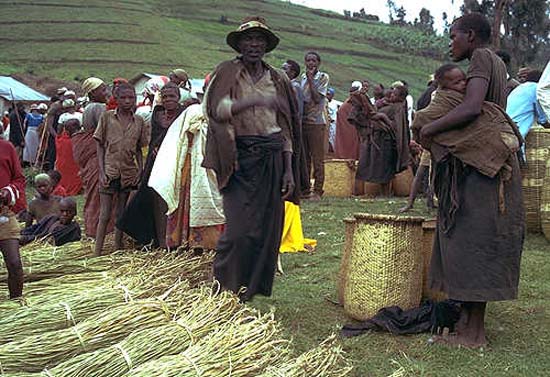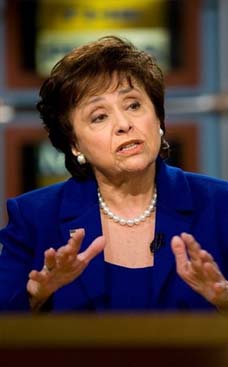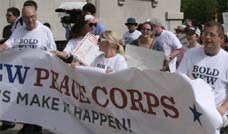
Producing enough food to satisfy domestic markets is a challenge that countries throughout Sub-Saharan Africa face. But for places in Africa where conflict and war prevail, the threat of hunger and malnutrition is particularly acute. For many, the biggest obstacle is accessibility, as internal conflict often limits a farmer's ability to get her products to market. When this occurs, vulnerable and marginalized groups often suffer the most.
Dominican Republic RPCV Danielle Nierenberg writes: Where Conflict Meets Cultivation
Where Conflict Meets Cultivation
Posted by Danielle Nierenberg on @ 11:08 am
Part I: Farming in Sudan's War-Torn Darfur Region
Producing enough food to satisfy domestic markets is a challenge that countries throughout Sub-Saharan Africa face. But for places in Africa where conflict and war prevail, the threat of hunger and malnutrition is particularly acute. For many, the biggest obstacle is accessibility, as internal conflict often limits a farmer's ability to get her products to market. When this occurs, vulnerable and marginalized groups often suffer the most.
This is just one of the issues that exacerbate food insecurity in Sudan's Darfur region, where farmers are often placed in direct conflict with militias groups over access to water and farm land. As the United Nations media service has observed, "The conflict pits farming communities against nomads who have aligned themselves with the militia groups – for whom the raids are a way of life – in stiff competition for land and resources. The militias, known as the Janjaweed, attack in large numbers on horseback and camels and are driving the farmers from their land, often pushing them towards town centers."
Most of the population of North Darfur is dependent on locally produced grain for food, but local harvests rarely produce more than 15 percent of the region's food needs, increasing the region's reliance on emergency food aid. In response to local farmers' limited access to seed and other inputs, groups like the U.N. Food and Agriculture Organization have succeeded in supplying thousands of local farmers with seed and farming tools since the conflict first erupted in 2003.
The cash generated by programs that support farmers' livelihoods often go towards children's education and health care and allow the purchase of essential goods and services such as clothes, mats, oil and sugar. However, with continued conflict, drought, and failed harvests to contend with, the prospects for farming in Darfur remain extremely limited.
Part II: Farming in the Niger Delta
nigerNigeria's Niger Delta region (located in the southern tip of the nation) is blessed with natural resources. The region contains some of the country's most fertile land, ideal for producing cassava, rubber, timber, and pineapple. But, instead of capitalizing on the region's arable land and natural resource endowment, local farmers have been handicapped by years of conflict and environmental degradation.
Foreign engineers first discovered oil in the Niger Delta in 1953. Since then, thousands of oil spills have polluted the water, soil and air across the region, destroying the livelihoods of fishermen and farmers. In fact, more oil is spilled in the Niger Delta every year than was lost in the Gulf of Mexico this past summer. According to the Nigerian government, approximately 7,000 oil spills (of varying sizes) occurred between 1970 and 2000.
Unfortunately, the state's economic dependence on crude oil exploration has also led to inadequate investment in the agricultural sector. Indeed, annual production of both cash and staple food crops has dropped significantly since oil was first discovered. For example, although Nigeria was the world's largest cocoa exporter in 1960, cocoa production has since dropped by 43 percent. And rubber production has dropped by 29 percent, cotton by 65 percent, and groundnuts by 64 percent.
The militarization of the region by local militia groups has produced yet another threat to the region's agriculture sector. Since the early 1990s, competition for oil wealth has fueled violence between ethnic militia groups, the Nigerian military and police forces. While militia groups claim to attack or siphon off oil from pipelines or wells in order to prompt government officials (at the state and federal level) to direct more oil revenue toward development activities in the region, their actions have had a debilitating effect on local farmers. The Niger Delta's fertile land should draw private investment from across the country, but with the constant threat of oil spills and social unrest, investors have been wary.
Recognizing that Nigeria was once able to produce enough food to feed its people, as well as supply raw materials to local industries and for export, the federal government seems poised for a change of course. With any luck, the government will lead the way for investors to rediscover the agricultural potential of the Niger Delta, unveiling the region's enormous untapped potential and enabling farmers to reclaim their livelihoods.
Part III: Rebuilding Liberian Farms in the Aftermath of War
contflit3After fourteen years of bloody civil war from1989 to 2003, Liberia has struggled to overcome aftermath of conflict. Some 10 percent of the population, 3 million people, was killed, and most of the country's physical infrastructure, including roads and bridges, was destroyed. Food production also suffered.
According to the World Food Program, 39 percent of Liberian children under the age of five are stunted, and 27 percent are underweight as a result of food shortages. More than 40 percent of people are malnourished in more than half of the nation's counties, while between 30-40 percent of people are malnourished in the remaining six counties.
For farmers like Lincoln Yeneken, low productivity, limited access to tools and seed, crop pests, and an inadequate road network, are major obstacles to agricultural development. In an interview with allAfrica.com, Yeneken said, "within the next five years I would like to plant coffee and rubber but I need tools and help to rebuild," as he pointed to the frames of the simple huts and granary for the rice he is now putting up. Yeneken's modest but productive subsistence farm and traps for bush meat are already doing relatively well, producing enough rice, cassava, plantain, and eddoes to feed his family and pay for his children's school fees. But during the rainy season, his fields turn into swamp lands, dramatically raising the incidence of malaria infections and making it all but impossible to raise enough food.
Non-governmental organizations (NGOs) like the Agricultural Cooperative Development International and Volunteers in Overseas Cooperative Assistance (ACDI/VOCA) are trying to address these problems, by working with farmers on drainage projects, activities to improve their agricultural skills and improve their access to farming equipment and credit, but many Liberian farmers remain untouched by such programs.
The government's limited capacity means that most of the county-level work in agriculture is currently being done by NGOs, but under the leadership of President Ellen Johnson-Sirleaf, there is hope that this will soon change, particularly with increased private investment in Liberia. Her administration has made it clear that paying more attention to the agriculture sector is one of the keys to kick starting the economy. President Johnson-Sirleaf stated at a Symposium on Global Agriculture and Food Security of the Global Agricultural Development Initiative in Washington DC over the summer that "our policy goal in the sector is to revitalize operations and activities that contribute to sustainable economic growth and development; to provide food security and nutrition; and to increase farmers' employment and income – all aimed at measurably reducing poverty."
In the wake of such a long and devastating civil war, there is no shortage of work for the Liberian government. But, among the long list of projects to be undertaken, helping small-scale farmers to rebound is the only way to ensure that Liberia is set on the road to recover.
Parts I, II, and III were originally featured as a three-part blog series on the Worldwatch Institute's Nourishing the Planet blog.
Danielle Nierenberg, an expert on livestock and sustainability, currently serves as Project Director of State of World 2011 for the Worldwatch Institute (www.NourishingthePlanet.org), a Washington, DC-based environmental think tank. Her knowledge of factory farming and its global spread and sustainable agriculture has been cited widely in The New York Times Magazine, the International Herald Tribune, The Washington Post, and other publications. Danielle worked for two years as a Peace Corps volunteer in the Dominican Republic and volunteers at farmers markets, the Earth Sangha (an urban reforestation organization), and Citizen Effect (an NGO focused on sustainable development projects all over the world). She has spent the last year traveling to more than 25 countries across sub-Saharan Africa looking at environmentally sustainable ways of alleviating hunger and poverty. She holds an M.S. in Agriculture, Food, and Environment from Tufts University and a B.A. in Environmental Policy from Monmouth College. Websites: www.worldwatch.org www.nourishingtheplanet.org Twitter: @worldwatchag













